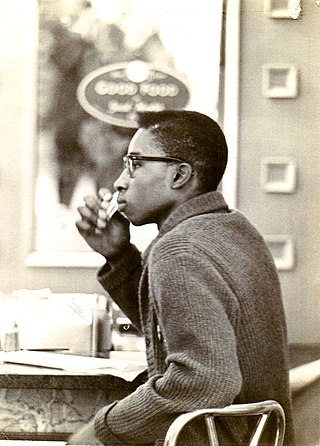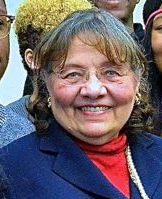
Caryn Elaine Johnson, known professionally as Whoopi Goldberg, is an American actor, comedian, author, and television personality. A recipient of numerous accolades, she is one of 19 entertainers to win the EGOT, which includes an Emmy Award, a Grammy Award, an Academy Award, and a Tony Award. In 2001, she received the Mark Twain Prize for American Humor.

A sit-in or sit-down is a form of direct action that involves one or more people occupying an area for a protest, often to promote political, social, or economic change. The protestors gather conspicuously in a space or building, refusing to move unless their demands are met. The often clearly visible demonstrations are intended to spread awareness among the public, or disrupt the goings-on of the protested organisation. Lunch counter sit-ins were a nonviolent form of protest used to oppose segregation during the civil rights movement, and often provoked heckling and violence from those opposed to their message.

Diane Judith Nash is an American civil rights activist, and a leader and strategist of the student wing of the Civil Rights Movement.

The Greensboro sit-ins were a series of nonviolent protests in February to July 1960, primarily in the Woolworth store—now the International Civil Rights Center and Museum—in Greensboro, North Carolina, which led to the F. W. Woolworth Company department store chain removing its policy of racial segregation in the Southern United States. While not the first sit-in of the civil rights movement, the Greensboro sit-ins were an instrumental action, and also the best-known sit-ins of the civil rights movement. They are considered a catalyst to the subsequent sit-in movement, in which 70,000 people participated. This sit-in was a contributing factor in the formation of the Student Nonviolent Coordinating Committee (SNCC).

The Big Six—Martin Luther King Jr., James Farmer, John Lewis, A. Philip Randolph, Roy Wilkins and Whitney Young—were the leaders of six prominent civil rights organizations who were instrumental in the organization of the March on Washington for Jobs and Freedom in 1963, at the height of the Civil Rights Movement in the United States.

The Nashville sit-ins, which lasted from February 13 to May 10, 1960, were part of a protest to end racial segregation at lunch counters in downtown Nashville, Tennessee. The sit-in campaign, coordinated by the Nashville Student Movement and the Nashville Christian Leadership Council, was notable for its early success and its emphasis on disciplined nonviolence. It was part of a broader sit-in movement that spread across the southern United States in the wake of the Greensboro sit-ins in North Carolina.
Cox v. Louisiana, 379 U.S. 536 (1965), is a United States Supreme Court case based on the First Amendment to the U.S. Constitution. It held that a state government cannot employ "breach of the peace" statutes against protesters engaging in peaceable demonstrations that may potentially incite violence.
The Friendship Nine, or Rock Hill Nine, was a group of African-American men who went to jail after staging a sit-in at a segregated McCrory's lunch counter in Rock Hill, South Carolina in 1961. The group gained nationwide attention because they followed the 1960 Nashville sit-ins strategy of "Jail, No Bail", which lessened the huge financial burden civil rights groups were facing as the sit-in movement spread across the South. They became known as the Friendship Nine because eight of the nine men were students at Rock Hill's Friendship Junior College.
Douglas E. Moore was a Methodist minister who organized the 1957 Royal Ice Cream Sit-in in Durham, North Carolina. Moore entered the ministry at a young age. After finding himself dissatisfied with what he perceived as a lack of action among his divinity peers, he decided to take a more activist course. Shortly after becoming a pastor in Durham, Moore decided to challenge the city's power structure via the Royal Ice Cream Sit-in, a protest in which he and several others sat down in the white section of an ice cream parlor and asked to be served. The sit-in failed to challenge segregation in the short run, and Moore's actions provoked a myriad of negative reactions from many white and African-American leaders, who considered his efforts far too radical. Nevertheless, Moore continued to press forward with his agenda of activism.

Clara Shepard Luper was a civic leader, schoolteacher, and pioneering leader in the American Civil Rights Movement. She is best known for her leadership role in the 1958 Oklahoma City sit-in movement, as she, her young son and daughter, and numerous young members of the NAACP Youth Council successfully conducted carefully planned nonviolent sit-in protests of downtown drugstore lunch-counters, which overturned their policies of segregation. The success of this sit-in would result in Luper becoming a leader of various sit-ins throughout Oklahoma City between 1958 and 1964. The Clara Luper Corridor is a streetscape and civic beautification project from the Oklahoma Capitol area east to northeast Oklahoma City. In 1972, Clara Luper was an Oklahoma candidate for election to the United States Senate. When asked by the press if she, a black woman, could represent white people, she responded: “Of course, I can represent white people, black people, red people, yellow people, brown people, and polka dot people. You see, I have lived long enough to know that people are people.”

Bernard Lafayette, Jr. is an American civil rights activist and organizer, who was a leader in the Civil Rights Movement. He played a leading role in early organizing of the Selma Voting Rights Movement; was a member of the Nashville Student Movement; and worked closely throughout the 1960s movements with groups such as the Student Nonviolent Coordinating Committee (SNCC), the Southern Christian Leadership Conference (SCLC), and the American Friends Service Committee.
The Dockum Drug Store sit-in was one of the first organized lunch counter sit-ins for the purpose of integrating segregated establishments in the United States. The protest began on July 19, 1958 in downtown Wichita, Kansas, at a Dockum Drug Store, in which protesters would sit at the counter all day until the store closed, ignoring taunts from counter-protesters. The sit-in ended three weeks later when the owner relented and agreed to serve black patrons. Though it wasn't the first sit-in, it is notable for happening before the well known 1960 Greensboro sit-ins.

The March trilogy is an autobiographical black and white graphic novel trilogy about the Civil rights movement, told through the perspective of civil rights leader and U.S. Congressman John Lewis. The series is written by Lewis and Andrew Aydin, and illustrated and lettered by Nate Powell. The first volume, March: Book One, was published in August 2013, by Top Shelf Productions. and the second volume, March: Book Two, was published in January 2015, with both volumes receiving positive reviews. March: Book Three was published in August 2016 along with a slipcase edition of the March trilogy.
The Daytime Emmy Award for Outstanding Performer in Children's Programming was an Emmy award given to performers in television programming aimed towards children. During the 1970s and 1980s, guest performers in dramatic specials and regular performers on children's series competed in the same category. However, starting in 1989, separate categories for performances in children's series and performances in children's specials were created and used until after 2007 when all categories related to Children's Specials were dropped.
The history of the 1954 to 1968 American civil rights movement has been depicted and documented in film, song, theater, television, and the visual arts. These presentations add to and maintain cultural awareness and understanding of the goals, tactics, and accomplishments of the people who organized and participated in this nonviolent movement.
Oretha Castle Haley was an American civil rights activist in New Orleans where she challenged the segregation of facilities and promoted voter registration. She came from a working-class background, yet was able to enroll in the Southern University of New Orleans, SUNO, then a center of student activism. She joined the protest marches and went on to become a prominent activist in the Civil Rights Movement.

The sit-in movement, sit-in campaign or student sit-in movement, were a wave of sit-ins that followed the Greensboro sit-ins on February 1, 1960 in North Carolina. The sit-in movement employed the tactic of nonviolent direct action and was a pivotal event during the Civil Rights Movement.
Joseph Charles Jones was an American civil rights leader, attorney, co-founder of the Student Nonviolent Coordinating Committee (SNCC), and chairperson of the SNCC's direct action committee.
Barbara Ann Posey Jones is an American economist who was a leader of the 1958 Katz Drug Store sit-in as a high school student. Since 1971, she has been a professor of economics, department head, and Dean at several historically Black Colleges and Universities in the American South. She is a past president of the National Economic Association.